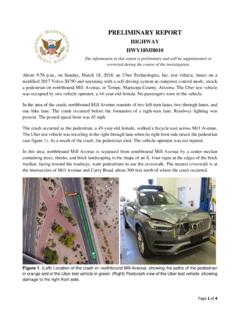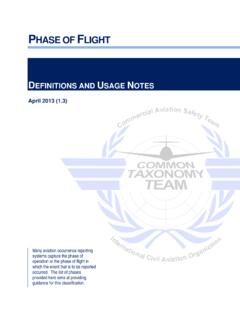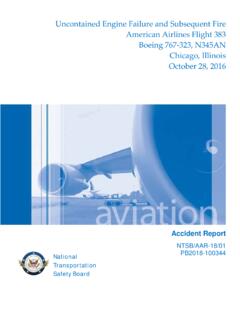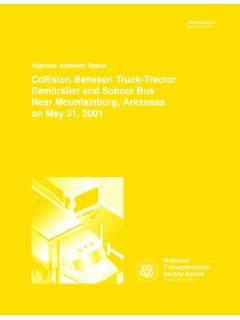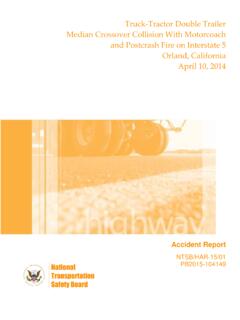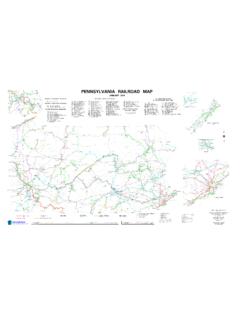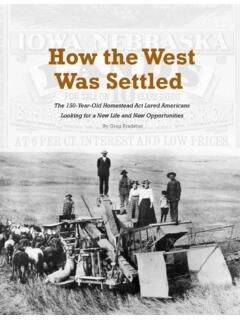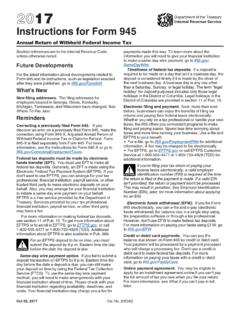Transcription of Loss of Control on Approach Colgan Air, Inc. Operating as ...
1 Loss of Control on Approach Colgan Air, Inc. Operating as Continental Connection Flight 3407. Bombardier DHC-8-400, N200WQ. Clarence Center, New York February 12, 2009. Accident Report NTSB/AAR-10/01. PB2010-910401. National Transportation Safety Board NTSB/AAR-10/01. PB2010-910401. Notation 8090A. Adopted February 2, 2010. Aircraft Accident Report Loss of Control on Approach Colgan Air, Inc. Operating as Continental Connection Flight 3407. Bombardier DHC-8-400, N200WQ. Clarence Center, New York February 12, 2009. National Transportation Safety Board 490 L'Enfant Plaza, Washington, 20594. National Transportation Safety Board. 2010. Loss of Control on Approach , Colgan Air, Inc., Operating as Continental Connection Flight 3407, Bombardier DHC-8-400, N200WQ, Clarence Center, New York, February 12, 2009. NTSB/AAR-10/01. Washington, DC. Abstract: This report discusses the accident involving a Colgan Air, Inc., Bombardier DHC-8-400, N200WQ, Operating as Continental Connection flight 3407, which experienced a loss of Control on an instrument Approach to Buffalo-Niagara International Airport, Buffalo, New York, and crashed into a residence in Clarence Center, New York, about 5 nautical miles northeast of the airport.
2 The safety issues discussed in this report focus on strategies to prevent flight crew monitoring failures, pilot professionalism, fatigue, remedial training, pilot training records, airspeed selection procedures, stall training, Federal Aviation Administration (FAA) oversight, flight operational quality assurance programs, use of personal portable electronic devices on the flight deck, the FAA's use of safety alerts for operators to transmit safety-critical information, and weather information provided to pilots. Safety recommendations concerning these issues are addressed to the FAA. The National Transportation Safety Board (NTSB) is an independent federal agency dedicated to promoting aviation, railroad , highway, marine, pipeline, and hazardous materials safety. Established in 1967, the agency is mandated by Congress through the Independent Safety Board Act of 1974 to investigate transportation accidents, determine the probable causes of the accidents, issue safety recommendations, study transportation safety issues, and evaluate the safety effectiveness of government agencies involved in transportation.
3 The NTSB makes public its actions and decisions through accident reports, safety studies, special investigation reports, safety recommendations, and statistical reviews. Recent publications are available in their entirety on the Internet at < >. Other information about available publications also may be obtained from the website or by contacting: National Transportation Safety Board Records Management Division, CIO-40. 490 L'Enfant Plaza, SW. Washington, DC 20594. (800) 877-6799 or (202) 314-6551. NTSB publications may be purchased, by individual copy or by subscription, from the National Technical Information Service. To purchase this publication, order report number PB2010-910401 from: National Technical Information Service 5285 Port Royal Road Springfield, Virginia 22161. (800) 553-6847 or (703) 605-6000. The Independent Safety Board Act, as codified at 49 Section 1154(b), precludes the admission into evidence or use of NTSB reports related to an incident or accident in a civil action for damages resulting from a matter mentioned in the report.
4 NTSB Aircraft Accident Report Contents Tables ..v Abbreviations .. vi Executive Summary ..x 1. Factual Information ..1. History of Injuries to Persons ..6. Damage to Aircraft ..6. Other Damage ..6. Personnel The Captain ..6. Activities in the 72 Hours Preceding the Accident ..8. Federal Aviation Administration Certificate Disapprovals and Colgan Air Training Events ..9. The First Officer ..11. Activities in the 72 Hours Preceding the Accident ..13. Previous Stall Training ..14. Aircraft Information ..15. Weight and Balance Information and Performance Data ..15. Airspeed Indications ..16. Stall Protection System ..18. Ice Detection and Deicing System ..19. Maintenance Records ..21. Meteorological Information ..22. Aids to Navigation ..23. Communications ..24. Airport Air Traffic Control ..24. Flight Recorders ..25. Cockpit Voice Flight Data Recorder ..26. Wreckage and Impact Information ..26. Medical and Pathological Information.
5 28. Fire ..28. Survival Aspects ..28. Fire Emergency Natural Gas Emergency Response ..28. i NTSB Aircraft Accident Report Tests and Aircraft Performance Study ..30. Aircraft Performance Simulation Organizational and Management Information ..33. Flight Crew Training ..34. Stall Training ..35. Winter Operations Training ..38. Remedial Training ..39. Crew Resource Management Training ..39. Captain Leadership Training ..41. Flight Manuals ..42. Reference and Approach Speeds ..42. Operations in Icing Conditions ..42. Descent, Approach , and Before Landing Checklists ..44. Approach Profile and Stabilized Approach Criteria ..44. Sterile Cockpit Commuting Policy ..46. Commuting Status of Pilots Based at Newark ..47. Fatigue Policy ..48. Crew Room Policy ..50. Safety Programs ..51. Safety Management and Safety Reporting Methods ..53. Aviation Safety Action Line Operations Safety Audit ..55. Flight Operational Quality Assurance.
6 55. Additional Postaccident Actions ..56. Safety Communications at the Newark Base ..57. Additional Information ..57. Previous Safety Sterile Cockpit Adherence ..57. Situational Pilot Professionalism ..58. Monitoring Pilot Responsibilities ..59. Flight Crew Fatigue ..60. Stall Training ..63. Remedial Training and Additional Oversight ..65. Pilot Records ..66. Air Carrier Safety Programs ..69. Air Carrier Oversight ..70. Low-Airspeed Alerting System ..71. Airplane Icing ..72. Weather Information for Pilots ..73. Federal Aviation Administration Guidance ..74. Pilot Records Improvement Line Operations Safety Audits ..74. ii NTSB Aircraft Accident Report Flight Operational Quality Assurance ..75. Standard Operating Procedures ..75. Interview with Colgan Air Flight Crew of Burlington, Vermont Stick Shaker Event ..76. Previous Related Accident ..77. Gulfstream Training Academy Information ..78. 2. Analysis ..80. General.
7 80. Accident Sequence ..81. Overview ..81. Approach to Airport ..83. Possible Reasons for Failed Detection of Impending Stick Shaker Onset ..84. Response to Stick Shaker Activation ..86. Possible Reasons for Failed Recovery Procedures ..89. Captain's Management of Flight ..91. Strategies to Prevent Monitoring Failures ..93. Flight Crew Monitoring Training ..93. Flight Deck Procedures ..95. Low-Airspeed Alert Systems ..95. Pilot Professionalism ..98. Leadership Training ..98. Sterile Cockpit and Standard Operating Crew Resource Management ..103. Fatigue ..104. Role of Fatigue in Flight Crew Performance ..106. Industry Fatigue Mitigation Efforts ..108. First Officer's Illness Symptoms ..113. Captain's Disapprovals and Training Problems ..114. Remedial Training and Additional Oversight ..117. Pilot Training Records ..119. Pilot Records Improvement Airspeed Selection Procedures ..123. Stall Training ..126. Stick Pusher Simulator Fidelity.
8 130. Tailplane Stall Training ..134. Federal Aviation Administration Oversight ..135. Company Policies ..139. Flight Operational Quality Assurance ..139. Use of Personal Portable Electronic Devices on the Flight Safety Alerts for Operators ..144. Preflight Weather Documents and Icing Terminology ..145. Preflight Weather Documents ..145. Icing Terminology ..148. iii NTSB Aircraft Accident Report 3. Conclusions ..151. Findings ..151. Probable Cause ..155. 4. Recommendations ..156. New Recommendations ..156. Previously Issued Recommendations Reiterated in This Report ..159. Previously Issued Recommendations Reclassified in This Report ..160. Board Member Statements ..161. 5. Appendix A Investigation and Hearing ..174. Appendix B Cockpit Voice Recorder Transcript ..175. iv NTSB Aircraft Accident Report Figures Figure 1. Q400 Indicated Airspeed Display ..17. Figure 2. Q400 Reference Speeds Figure 3. Q400 Engine Display Showing Ice Detected and Increased Reference Speeds Message.
9 20. Tables Table 1. Injury Chart ..6. Table 2. Colgan Air's Approach -to-Stall Training Events ..35. Table 3. Geographic Distribution of Colgan Air Pilots Based at Newark, New Jersey ..48. Table 4. Icing Definitions ..149. v NTSB Aircraft Accident Report Abbreviations AAIB Air Accidents Investigation Branch of the United Kingdom AC advisory circular ACARS aircraft communications addressing and reporting system AFM airplane flight manual agl above ground level AIM Aeronautical Information Manual AIRMET Airmen's Meteorological Information ALB Albany International Airport ALPA Air Line Pilots Association AOA angle-of-attack AOM airplane Operating manual APM aircrew program manager ASAP aviation safety action program ASIAS aviation safety information analysis and sharing ASOS automated surface observing system ASRS Aviation Safety Reporting System ATC air traffic Control ATCT air traffic Control tower ATIS automatic terminal information service ATOS air transportation oversight system BTV Burlington International Airport BUF Buffalo-Niagara International Airport vi NTSB Aircraft Accident Report CFM company flight manual CFR Code of
10 Federal Regulations CRM crew resource management CVR cockpit voice recorder CWA Center Weather Advisory DOD Department of Defense eice en route ice accumulation EWR Newark Liberty International Airport FAA Federal Aviation Administration FDR flight data recorder FOQA flight operational quality assurance FRMS fatigue risk management system FSDO flight standards district office GIA Gulfstream International Airlines Hg mercury IAH George Bush Intercontinental Airport IAS indicated airspeed IATA International Air Transport Association ICAO International Civil Aviation Organization IEP internal evaluation program IFR instrument flight rules ILS instrument landing system InFO information for operators IOE initial Operating experience vii NTSB Aircraft Accident Report LOSA line operations safety audit MEM Memphis International Airport METAR meteorological aerodrome report msl mean sea level MSP Minneapolis-St. Paul International/Wold-Chamberlain Airport NASA National Aeronautics and Space Administration NDB nondirectional beacon nm nautical mile NOTAM notice to airmen NPRM notice of proposed rulemaking NTSB National Transportation Safety Board NWS National Weather Service ORF Norfolk International Airport PF pilot flying PFD primary flight display PIC pilot-in-command PIREP pilot report PM pilot monitoring POI principal operations inspector PRIA Pilot Records Improvement Act PST Pacific standard time QAR quick access recorder RDU Raleigh-Durham International Airport ROC Greater Rochester International Airport viii NTSB Aircraft Accident Report SAFO safety alert for operators SEA Seattle-Tacoma International Airport SIC second-in-command SIGMET Significant Meteorological Information SMS safety management system TSB Transportation Safety Board of Canada Vfri flap retract speed Vga go-around speed V ref reference




